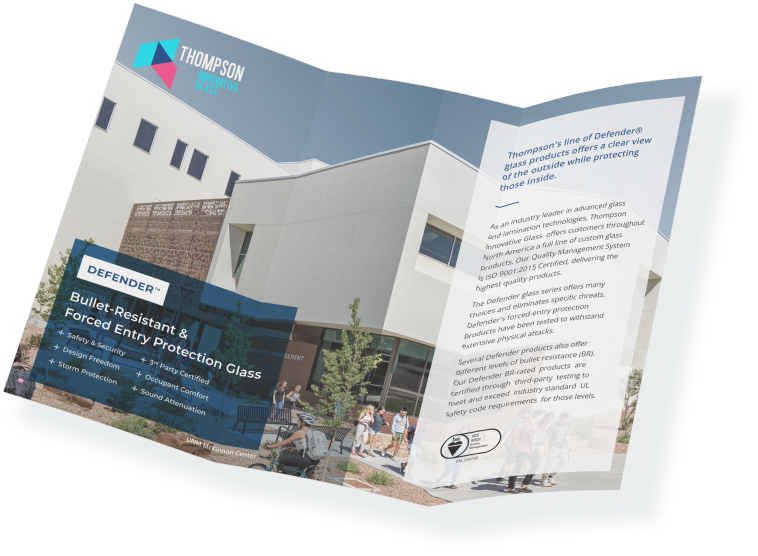Government Buildings
Federal and municipal buildings require protective glazing that supports security mandates while upholding civic transparency and design intent.
Thompson Innovative Glass manufactures several Bullet-Resistant (also called Bullet Proof or Ballistic) Glass options under our Defender® line.
Forced Entry & Bullet Resistant (“FEBR”): This type of security glass is designed to provide both forced entry and bullet resistant protection. Thompson FEBR glass solutions are available in IGU, Glass Glad and Glass Glad-All Glass constructions. FEBR glass is frequently used in applications where a very high level of security is needed such as courtrooms, government buildings, financial institutions and correctional facilities.
Defender forced entry glass features multiple make-ups and performance levels and can be combined with energy efficiency products as well as bird-friendly materials
Check with the Thompson Innovative Glass team for more details and options from our Defender line to find the right one for you and your application.
Thompson Innovative Glass works with only best in clear float glass featuring high quality and aesthetic appeal.
Available tints include a variety of grays, bronzes, blues, and greens. Contact Thompson Innovative Glass for more specific details and samples.
Thompson Innovative Glass carries reflective glass with varying performance & reflectance. Contact us for more specific details and samples.
Where clear vision is required, and specific lighting conditions can be achieved. It offers an effective means of providing undetected surveillance and one-way vision to achieve privacy.
Thompson Innovative Glass carries glass thicknesses from 1/8” to 3/4” giving you the best range to meet your products specifications.
Bullet resistant and forced entry glass are critical components in protecting people and property across a wide range of high-risk environments. These specialized glazing solutions are trusted wherever enhanced security and peace of mind are essential, from public institutions to private facilities. Common applications include:
Federal and municipal buildings require protective glazing that supports security mandates while upholding civic transparency and design intent.
Security glazing enhances school safety by resisting forced entry and delaying intruders, providing critical response time without compromising light, visibility, or design.
Military facilities utilize protective glazing to defend against ballistic threats, forced entry, and blast events while maintaining structural integrity.
Banks and financial offices rely on secure glazing for transaction windows, teller areas, and entry points to protect employees and assets.
Glazing in correctional environments must meet rigorous standards for containment, safety, and visibility while withstanding impact and tampering.
Healthcare environments use safety and security glazing in patient rooms, lobbies, and sensitive areas to enhance protection and hygiene without sacrificing light or openness.
FEBR stands for Forced Entry and Bullet Resistant glass. It refers to glazing systems designed to resist both ballistic (gunfire) attacks and physical attacks such as prying, hammering, or battering with blunt or sharp objects. These systems are commonly used in government facilities, schools, financial institutions, utilities, and other sensitive infrastructure.
FEBR glass is often evaluated using a combination of standards, including:
UL 752 – For ballistic resistance (e.g., handgun or rifle levels)
ASTM F1233 – For forced entry resistance against various hand tools and impact methods
NIJ 0108.01 – Used in correctional or law enforcement contexts for bullet resistance
Many secure facilities will specify both UL and ASTM F1233 ratings for full FEBR performance.
ASTM F1233 is the Standard Test Method for Security Glazing Materials and Systems, specifically addressing resistance to forced entry using various attack tools like:
The standard includes tool-specific attack cycles and classifies glazing into categories based on how long the system withstands attack and what tools are used.
No. Most standard bullet-resistant glass is designed only to stop bullets, not to resist repetitive physical impacts from tools or blunt objects. To qualify as FEBR, the glass (and ideally the entire system) must be tested and certified for both ballistic and forced entry performance.
School security entry vestibules
Federal and state government buildings
Utility substations
Police stations and courthouses
High-end commercial or retail environments
Correctional facilities
Heavier and thicker than standard glass
Higher cost due to advanced materials and certification
Must be installed properly to achieve rated performance
Often limited in size or design flexibility (depending on ballistic level)
No. FEBR glass is not fire-rated by default. If fire and ballistic/forced-entry resistance are both required, specialized hybrid glazing systems must be specified and tested accordingly.
Discover all our Forced Entry Bullet Resistant options in our brochure.
Download Now